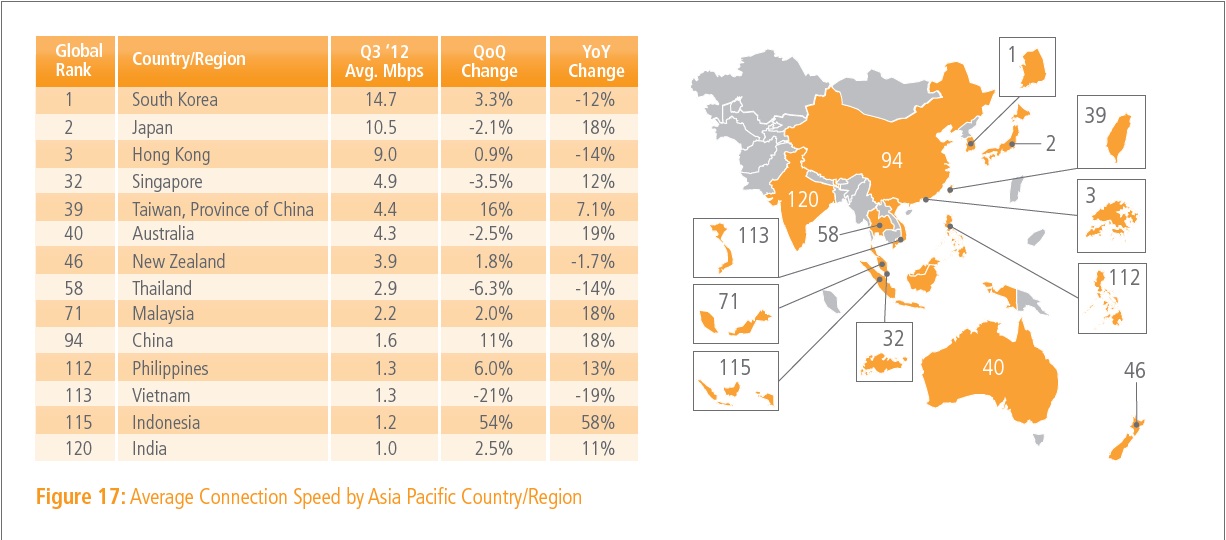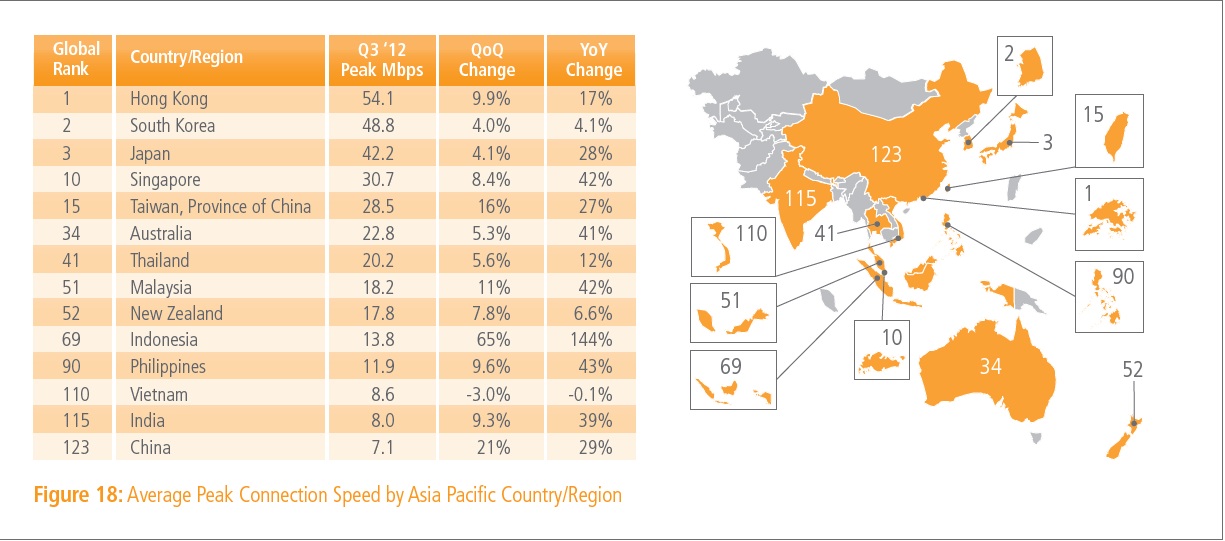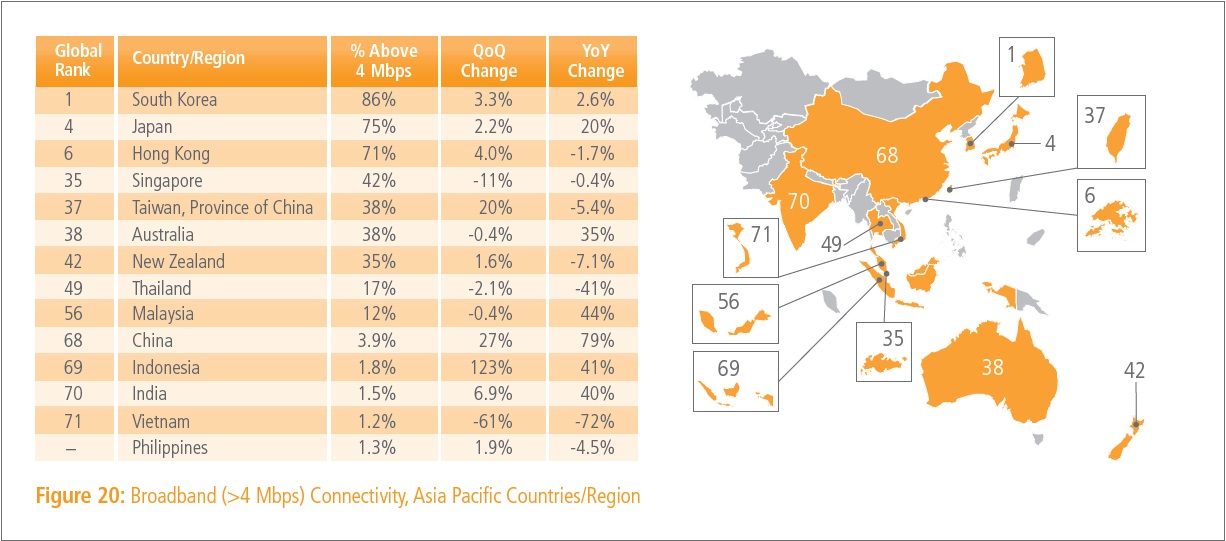State of the Internet: Malaysia lags Thailand, but improving
By A. Asohan January 25, 2013
- Asia has the fastest Internet connections, and is source of most cyber-attacks
- Malaysia’s Internet speeds still lagging, but catching up
 THE average speed of broadband connectivity in Malaysia (ranked 71) lags that of Thailand (58), but continues to improve, according to the quarterly State of the Internet Report released by web technologies company Akamai (click chart to enlarge) for the third quarter of 2012.
THE average speed of broadband connectivity in Malaysia (ranked 71) lags that of Thailand (58), but continues to improve, according to the quarterly State of the Internet Report released by web technologies company Akamai (click chart to enlarge) for the third quarter of 2012.
This was despite a hiccup in the last quarter, which saw the adoption of high-speed broadband – which Akamai defines as 10 Mbps and up – drop 28% quarter over quarter.
The rest of Asia continues to the lead the way, with the top three countries and region in the world for Internet connectivity speed being South Korea, Japan, and Hong Kong. However, Japan saw a drop in average connection speeds, as did Australia, Singapore, Thailand and Vietnam, with Vietnam’s 21% loss (to 1.3 Mbps) being the most significant.
Among those countries that saw positive quarter-over-quarter changes, growth ranged from Hong Kong’s 0.9% increase to a 54% jump in Indonesia (to 1.2 Mbps), with Malaysia somewhere between with an increase of 18% to 2.2 Mbps, the report stated.
India remained just slightly above the 1.0 Mbps mark, with a 2.5% quarter-over-quarter increase, and China continued to grow as well, up 11% from the second quarter to 1.6 Mbps, Akamai said.
Year-over-year changes were more mixed, with nine of the surveyed countries/regions seeing higher average connection speeds as compared to the third quarter of 2011, and five seeing lower speeds. Among the gainers, growth ranged from a still respectable 7.1% in Taiwan (to 4.4 Mbps) to a surprisingly large 58% increase in Indonesia.
Hong Kong remained the country/ region with the highest average peak connection speed, vaulting back past the 50 Mbps threshold, and growing 9.9% to 54.1 Mbps, putting it well ahead of South Korea, which grew 4.0% (to 48.8 Mbps) and Japan, which grew 4.1% (to 42.2 Mbps).
 Among the surveyed Asia Pacific countries/ regions, only Vietnam saw its average peak connection speed decline quarter-over-quarter, losing 3% to 8.6 Mbps. Growth levels varied across the other surveyed countries/regions, ranging from South Korea’s 4% increase to a massive 65% jump in Indonesia to 13.8 Mbps (click chart to enlarge).
Among the surveyed Asia Pacific countries/ regions, only Vietnam saw its average peak connection speed decline quarter-over-quarter, losing 3% to 8.6 Mbps. Growth levels varied across the other surveyed countries/regions, ranging from South Korea’s 4% increase to a massive 65% jump in Indonesia to 13.8 Mbps (click chart to enlarge).
Indonesia, Taiwan, Malaysia, and China all saw double-digit percentage changes quarter-over-quarter, though even with a 21% increase, China’s average peak connection speed of 7.1 Mbps was still the lowest of the group. India and Vietnam joined China as the only three countries in the Asia Pacific region to have average peak connection speeds under 10 Mbps.
“Hong Kong’s 54.1 Mbps average peak connection speed in the third quarter marks the first time that an average peak connection speed has exceeded 50 Mbps,” Akamai said.
In looking at year-over-year changes in average peak connection speeds, strong changes were seen across most of the surveyed countries/ regions, the company added.
Only Vietnam declined year-over-year, while South Korea and New Zealand were the only two countries that grew less that 10%, increasing 4.1% and 6.6% (to 17.8 Mbps), respectively. Among the other countries/ regions, Indonesia’s 144% yearly increase was far and away the largest one, though five others (Singapore, Australia, Malaysia, the Philippines, and India) all grew more than 30%.
China, Japan, and Taiwan were not too far behind, increasing average peak connection speeds by 29%, 28%, and 27% respectively.
Beginning this year onwards, Akamai has redefined the term “high broadband” to include connections to Akamai of 10 Mbps, which led to a number of countries no longer qualifying to be included in the list.
A large gap in high broadband adoption remained among the surveyed countries/ regions in the Asia Pacific region that qualified for inclusion, with adoption levels ranging from 52% in South Korea (highest in the region and globally) to just 0.2% in China.
Quarterly growth among these countries had a fairly broad range as well, from just 1.4% in New Zealand (to 2.4% adoption) to 43% in Taiwan (to 4.7% adoption). Singapore and Australia were the only two qualifying countries to see quarterly losses, with Singapore declining 3.2% (to 6.9% adoption) and Australia declining 13% (to 4.1% adoption).
 Among the countries that did not qualify for inclusion, they all had high broadband adoption levels below 1%. Significant quarterly losses were seen in Malaysia, Thailand, and Vietnam, with the latter dropping below 0.1% adoption (click chart to enlarge).
Among the countries that did not qualify for inclusion, they all had high broadband adoption levels below 1%. Significant quarterly losses were seen in Malaysia, Thailand, and Vietnam, with the latter dropping below 0.1% adoption (click chart to enlarge).
Akamai publishes the State of the Internet Report every quarter. This report includes data gathered from across the Akamai Intelligent Platform during the third quarter of 2012 about attack traffic, broadband adoption, and mobile connectivity, as well as trends seen in this data over time.
China No 1 source of cyber-attacks
China remained far and away the top traffic source for attack traffic, responsible for nearly a third. The United States and Russia held the second and third place spots respectively, accounting for just below 18% of observed attack traffic combined, Akamai said.
“In examining the regional distribution of observed attack traffic in the third quarter, we find that nearly 51% originated in the Asia Pacific/ Oceania region, just under 25% in Europe, just over 23% in North and South America, and slightly more than 1% from Africa,” the company said in the report.
“In contrast to the decline seen in the second quarter, the Asia Pacific/ Oceania region was the only one where any meaningful increase was seen in the third quarter, owing primarily to a doubling of the percentage of attack traffic observed to be originating from China.”
Attack traffic concentration increased from the second quarter of 2012, with the top 10 ports seeing 72% of observed attack traffic.
Towards the end of the third quarter, a set of distributed denial-of-service (DDoS) attacks targeted the websites of banks and other financial institutions.
Mobile connectivity
In the third quarter of 2012, average connection speeds on surveyed mobile network providers ranged from a high of 7.8 Mbps down to 324 kbps. Average peak connection speeds for the quarter ranged from 39.2 Mbps down to 2.8 Mbps.
Based on data collected by Ericsson, the volume of mobile data traffic doubled from the third quarter of 2011 to the third quarter of 2012, and grew 16% between the second and third quarter of 2012.
Analysis of Akamai data collected across the third quarter of a sample of requests to the Akamai Intelligent Platform indicates that for users of mobile devices on cellular networks, the largest percentage of requests (37.6%) came from Android Webkit, with Apple’s Mobile Safari close behind (35.7%).
However, for users of mobile devices across all networks (not just cellular), Apple’s Mobile Safari accounted for 60.1% of requests, with Android Webkit responsible for just 23.1%.
Related Stories:
Working on the next-gen Internet
Internet speeds: It’s not just about the infra, silly
For more technology news and the latest updates, follow @dnewsasia on Twitter or Like us on Facebook.


